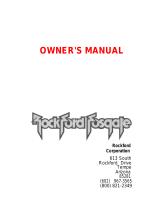
– 15 –
P ARTS LIST
DESIGNATOR VALUE PART #
ALL RESISTORS IN OHMS
R1 1.0K OHM 1/10W 1% RM/10-1001B
R10 47K OHM 1/10W 5% RM/10-473B
R100 10K OHM 1/10W 1% RM/10-1002B
R101 9.09KOHM 1/10W 1% RM/10-9091B
R102 1M OHM 1/10W 5% RM/10-105B
R103 10K OHM 1/10W 1% RM/10-1002B
R104 13K OHM 1/10W 5% RM/10-133B
R107 10K OHM 1/10W 1% RM/10-1002B
R109 14K OHM 1/10W 1% RM/10-1402B
R11 1.0K OHM 1/10W 1% RM/10-1001B
R110 14K OHM 1/10W 1% RM/10-1402B
R111 14K OHM 1/10W 1% RM/10-1402B
R112 13K OHM 1/10W 5% RM/10-133B
R113 10K OHM 1/10W 1% RM/10-1002B
R114 9.09KOHM 1/10W 1% RM/10-9091B
R12 10K OHM 1/10W 1% RM/10-1002B
R120 10K OHM 1/10W 1% RM/10-1002B
R121 620 OHM 1/10W 5% RM/10-621B
R122 620 OHM 1/10W 5% RM/10-621B
R123 1.74K OHM 1/10W 1% RM/10-1741B
R124 RES 0 OHM 1/4W RMP/4-0000-03
R125 RES 0 OHM 1/4W RMP/4-0000-03
R127 10K OHM 1/10W 1% RM/10-1002B
R129 100 OHM 1/10W 5% RM/10-101B
R13 470K OHM 1/10W 5% RM/10-474B
R130 8.25K OHM 1/10W 1% RM/10-8251B
R132 1.74K OHM 1/10W 1% RM/10-1741B
R136 POT 5K RV-502Q
R137 2.61K OHM 1/10W 1% RM/10-2611B
R14 100 OHM 1/4W 5% RM/4-101C
R145 10M OHM 1/10W 5% RM/10-106B
R146 10K OHM 1/10W 1% RM/10-1002B
R147 6.81K OHM 1/10W 1% RM/10-6811B
R15 3.3M OHM 1/10W 5% RM/10-335B
R156 10K OHM 1/10W 1% RM/10-1002B
R157 1.33K OHM 1/4W 1% RM/4-1331C
R158 1.33K OHM 1/4W 1% RM/4-1331C
R16 4.75K OHM 1/10W 1% RM/10-4751B
R164 8.25K OHM 1/10W 1% RM/10-8251B
R17 10K OHM 1/10W 1% RM/10-1002B
R18 100K OHM 1/10W 5% RM/10-104B
R19 604K OHM 1/10W 1% RM/10-6043B
R2 1.0K OHM 1/10W 1% RM/10-1001B
R20 100K OHM 1/10W 5% RM/10-104B
R21 2.2M OHM 1/10W 5% RM/10-225B
R22 100K OHM 1/10W 5% RM/10-104B
R23 56K OHM 1/10W 5% RM/10-563B
R24 1.0K OHM 1/10W 1% RM/10-1001B
R25 10K OHM 1/10W 1% RM/10-1002B
R26 1M OHM 1/10W 5% RM/10-105B
R27 121 OHM 1/10W 1% RM/10-1210B
R278 510 OHM 1/10W 5% RM/10-511B
R28 121 OHM 1/10W 1% RM/10-1210B
R29 KNOB 2-3 WAY CROSSOVER KN-1824-A
R29 POT QUAD 9MM 20K RV-203Q
R3 1.0K OHM 1/10W 1% RM/10-1001B
R30 100 OHM 1/4W 5% RM/4-101C
R31 300 OHM 1/10W 5% RM/10-301B
R32 47K OHM 1/10W 5% RM/10-473B
R33 4.75K OHM 1/4W 1% 1206 RM/4-4751C
R34 2K OHM 1/4W 1% RM/4-2001C
R35 820 OHM 1/4W 5% RM/4-821C
R36 3.3M OHM 1/10W 5% RM/10-335B
R37 10 OHM 1/10W 5% RM/10-100B
R38 300 OHM 1/10W 5% RM/10-301B
R39 300 OHM 1/10W 5% RM/10-301B
R4 47K OHM 1/10W 5% RM/10-473B
R40 20.0K OHM 1/10W 1% RM/10-2002B
R41 4.75K OHM 1/4W 1% RM/4-4751C
R42 47K OHM 1/10W 5% RM/10-473B
R43 1.0K OHM 1/10W 1% RM/10-1001B
R44 16.2K OHM 1/10W 1% RM/10-1622B
R45 1.0K OHM 1/10W 1% RM/10-1001B
R46 RES 28K OHM 1/4W 1% RMP/4-2802-04
R47 2.2M OHM 1/10W 5% RM/10-225B
R48 28K OHM 1/10W 1% RM/10-2802B
R49 1.74K OHM 1/10W 1% RM/10-1741B
R5 1.0K OHM 1/10W 1% RM/10-1001B
R50 5.11K OHM 1/4W 1% RM/4-5111C
R51 1.74K OHM 1/10W 1% RM/10-1741B
R52 3.3M OHM 1/10W 5% RM/10-335B
R53 2K OHM 1/4W 1% RM/4-2001C
R54 3.3M OHM 1/10W 5% RM/10-335B
R55 300 OHM 1/10W 5% RM/10-301B
R56 243 OHM 1/4W 1% RM/4-2430C
R57 470K OHM 1/10W 5% RM/10-474B
R58 POT 2K TRIM RV-202
R59 1.74K OHM 1/10W 1% RM/10-1741B
R6 100 OHM 1/10W 5% RM/10-101B
R60 300 OHM 1/10W 5% RM/10-301B
R61 14K OHM 1/10W 1% RM/10-1402B
R62 14K OHM 1/10W 1% RM/10-1402B
R63 300 OHM 1/10W 5% RM/10-301B
R64 14K OHM 1/10W 1% RM/10-1402B
R65 10K OHM 1/10W 1% RM/10-1002B
R66 1.74K OHM 1/10W 1% RM/10-1741B
R67 1.0K OHM 1/10W 1% RM/10-1001B
R68 100 OHM 1/4W 5% RM/4-101C
R69 2.0K OHM 1/10W 1% RM/10-2001B
R7 100 OHM 1/10W 5% RM/10-101B
R70 280 OHM 1/10W 1% RM/10-2800B
R71 10 OHM 1/10W 5% RM/10-100B
R72 100 OHM 1/4W 5% RM/4-101C
R73 10K OHM 1/10W 1% RM/10-1002B
R74 4.75K OHM 1/10W 1% RM/10-4751B
R75 4.75K OHM 1/10W 1% RM/10-4751B
R78 680 OHM 1/10W 5% RM/10-681B
R8 POT 2K TRIM RV-202
R80 300 OHM 1/10W 5% RM/10-301B
R81 300 OHM 1/10W 5% RM/10-301B
R82 232K OHM 1/10W 1% RM/10-2323B
R83 243 OHM 1/4W 1% RM/4-2430C
R84 100 OHM 1/10W 5% RM/10-101B
R85 8.25K OHM 1/10W 1% RM/10-8251B
R86 RES 10 OHM 1W RM1-100-012
R9 POT 2K TRIM RV-202
R98 8.25K OHM 1/10W 1% RM/10-8251B
RV1 KNOB 2-3 WAY CROSSOVER KN-1824-A
RV1 DUAL 5K LINEAR RV-502DPA
C1 10UF 16V CER-106SM
C10 10PF 50V CDS-100CAAA
C11 10UF 16V CER-106SM
C12 .1UF 50V CYV-104
C13 CAP 3300UF 35V CERS-338B
C14 .47UF 50V CYV-474
C15 .1UF 50V CDS-104CBBB
C16 .1UF 50V CDS-104CBBB
C17 .1UF 50V CDS-104CBBB
C18 .1UF 50V CDS-104CBBB
C19 .1UF 50V CDS-104CBBB
C2 CAP 3300UF 63V CERS-338E
C20 .1UF 50V CDS-104CBBB
C21 10PF 50V CDS-100CAAA
C22 .47UF 50V CYV-474
C23 .47UF 50V CYV-474
C24 .1UF 50V CDS-104CBBB
C25 .1UF 50V CDS-104CBBB
C26 47PF 100V CDS-470DAAA
C27 .1UF 50V CDS-104CBBB
C28 10UF 16V CER-106SM























